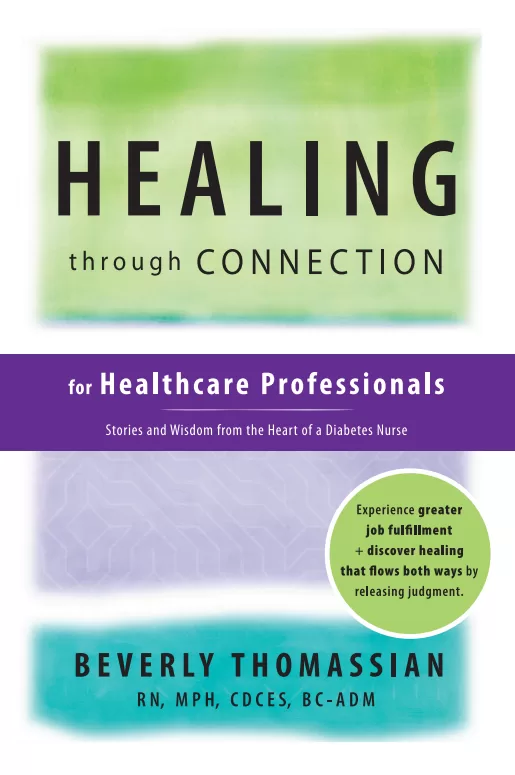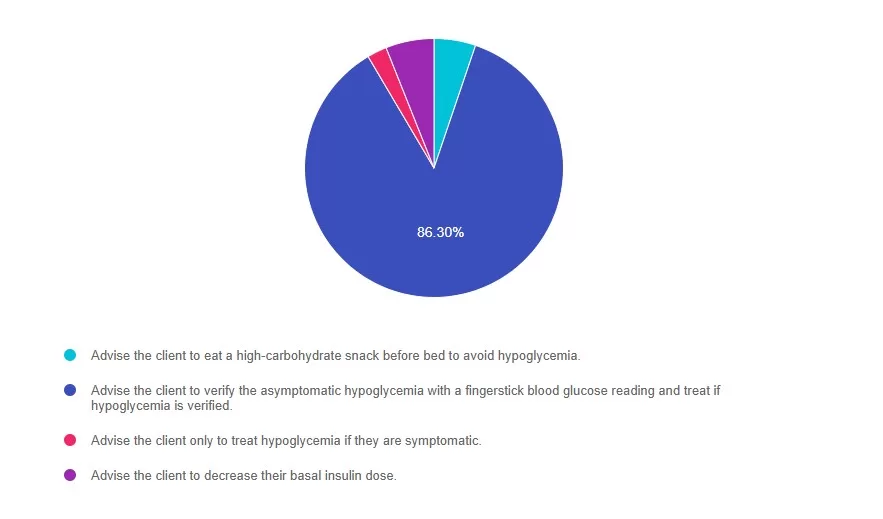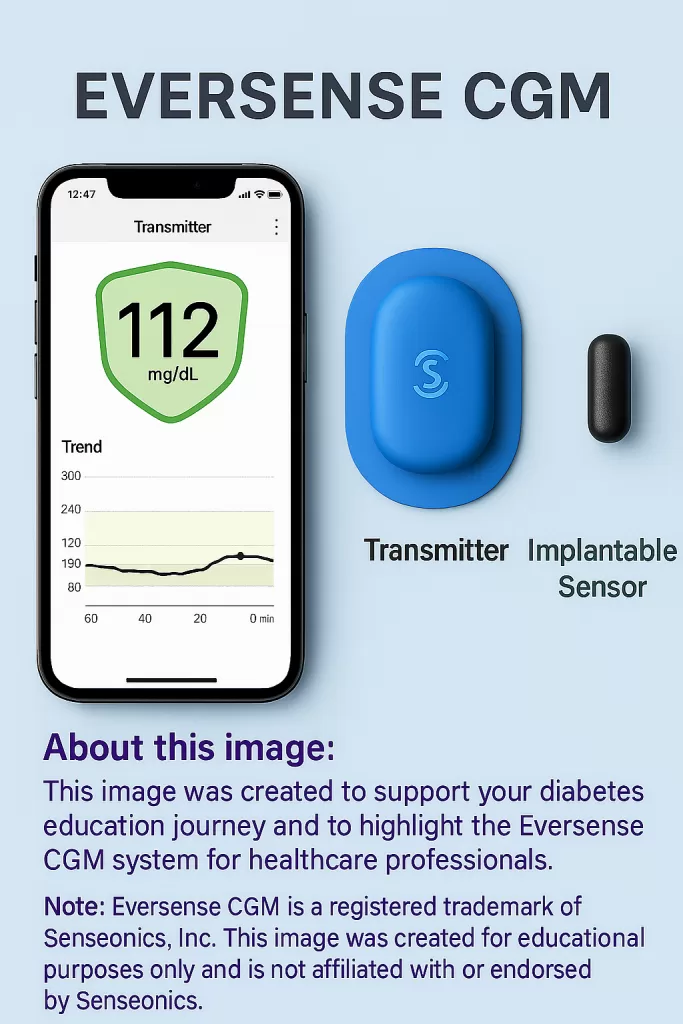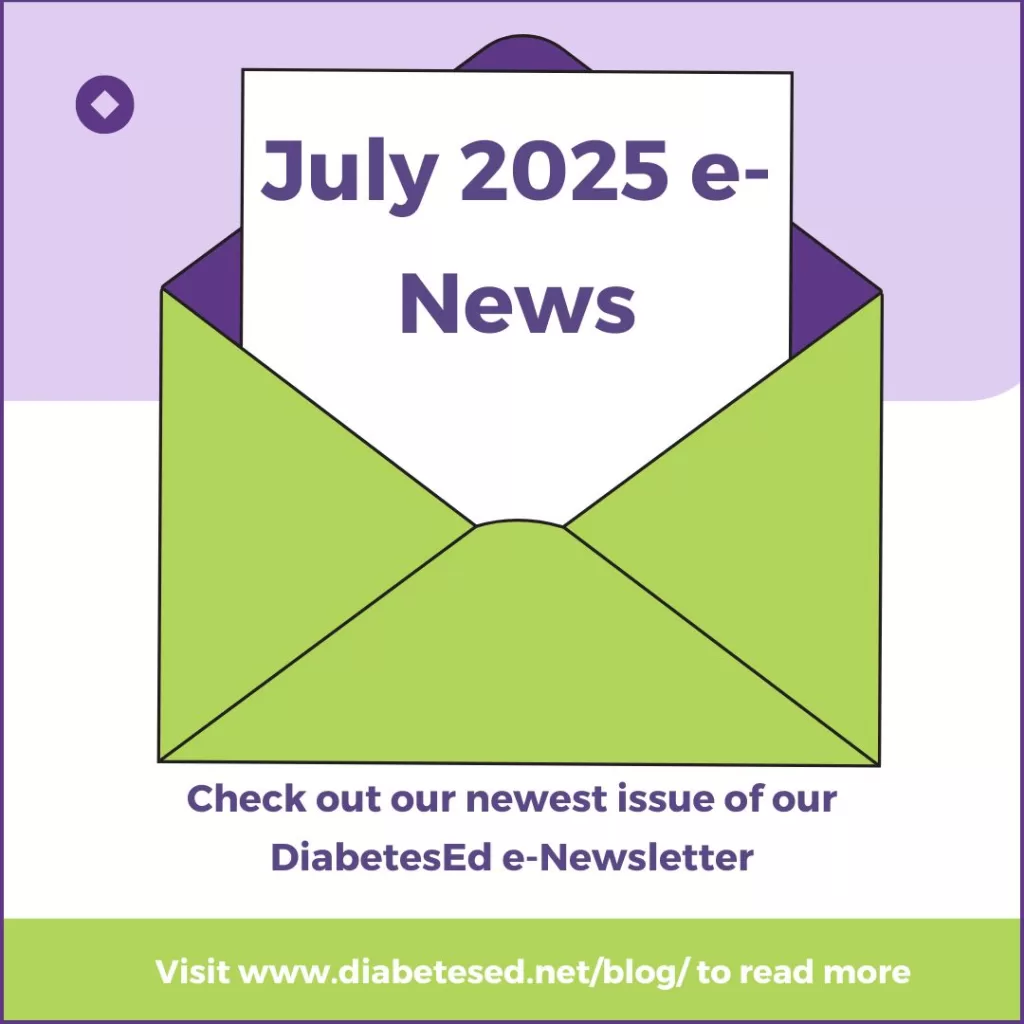
Ready to get certified?
Free CDCES Coach App

Subscribe
eNewsletter
Download
Free Med Pocket Cards
Rationale of the Week | What Helps Manage Gastroparesis in Type 1 Diabetes?
For last week’s practice question, we quizzed participants on What Helps Manage Gastroparesis in Type 1 Diabetes? 80% of respondents chose the best answer. We want to clarify and share this important information, so you can pass it on to people living with diabetes and your colleagues, plus prepare for exam success!
Before we start though, if you don’t want any spoilers and haven’t tried the question yet, you can answer it below: Answer Question

Question: VC has been living with type 1 diabetes for 43 years and was recently diagnosed with gastroparesis. Symptoms have included early satiety, nausea, bloating and intestinal pain. VC has an A1c of 6.7% but is experiencing frequent hypoglycemia. What general nutrition modifications would VC benefit from?
Answer Choices:
- Consume 3 meals per day, at the same time each day.
- Consume soft foods and include protein with meals to prevent hypoglycemia.
- Include small frequent meals, choose soft foods and reduce foods high in fat and fiber.
- Include high fiber foods and increase fluid intake to prevent constipation.

Getting to the Best Answer
Answer 1 is incorrect. 3% chose this answer, “Consume 3 meals per day, at the same time each day.” This approach can be helpful to manage glucose for some individuals with diabetes, however in gastroparesis timing, meal size, type of foods, and food textures are key.
Answer 2 is incorrect. 8% of you chose this answer, “Consume soft foods and include protein with meals to prevent hypoglycemia.” While soft foods and adequate protein is important, this doesn’t address the need to reduce fat and fiber and shift to smaller, more frequent meals.
Answer 3 is correct. About 80% of respondents chose this, “Include small frequent meals, choose soft foods and reduce foods high in fat and fiber.” Small frequent meals can improve rate of motility through the stomach to small intestine, low fat and low fiber whole foods also tend to move more quickly from the stomach (liquid sources may be tolerated better), and soft foods such as well-cooked vegetables to tender proteins may help reduce nausea, bloating and can ease the digestive process. Individual assessment of rate of digestion and insulin administration timing should also be considered to reduce the risk of post-prandial hypoglycemia.
Finally, Answer 4 is incorrect. 7% chose this answer, “Include high fiber foods and increase fluid intake to prevent constipation.” A high fiber diet can often worsen symptoms in gastroparesis by slowing gastric emptying further. Fluids are important, but fiber from whole foods is typically reduced.
We hope you appreciate this week’s rationale! Thank you so much for taking the time to answer our Question of the Week and participate in this fun learning activity!
DiabetesEd Training Seminar - Save $75 through July 23rd. Code SDLIVE


Join our expert team for engaging, interactive sessions that bring the ADA Standards of Care to life—covering medications, behavior change, technology, and more. Ideal for CDCES or BC-ADM exam prep, this course also includes a 4-hour Virtual Medical Nutrition Therapy Toolkit and bonus content that also meets CDCES renewal requirements.
Join us live October 22nd – 23rd, 2025!
30+ CEs with Expanded Accreditation!
Program Objectives:
Upon completion of this activity, participants should be able to:
- Describe the current ADA Standards for diagnosis, goals, and person-centered diabetes management across the lifespan.
- Demonstrate insulin pattern management and dosing strategies in clinical scenarios.
- Implement timely screening and risk reduction strategies for microvascular and cardiovascular complications.
- Incorporate behavior change techniques and medical nutrition therapy to support people with diabetes self-management and lifestyle adjustment.
Expert Faculty:

Diana Isaacs, PharmD, BCPS, BCACP, CDCES, BC-ADM, FADCES, FCCPCES

Beverly Thomassian, RN, MPH, CDCES, BC-ADM
Faculty Bios & Disclosures
Our expert team transforms complex diabetes science into clear, practical insights—keeping it real, engaging, and fun!
Program Faculty Disclosures:
Partners for Advancing Clinical Education (Partners) requires every individual in a position to control educational content to disclose all financial relationships with ineligible companies that have occurred within the past 24 months. Ineligible companies are organizations whose primary business is producing, marketing, selling, re-selling, or distributing healthcare products used by or on patients.
All relevant financial relationships for anyone with the ability to control the content of this educational activity are listed below and have been mitigated according to Partners policies. Others involved in the planning of this activity have no relevant financial relationships.
Faculy Bios & Disclosures:
 Coach Beverly Thomassian RN, MPH, CDCES, BC-ADM – CEO of DiabetesEd Services
Coach Beverly Thomassian RN, MPH, CDCES, BC-ADM – CEO of DiabetesEd ServicesDisclosures:
Beverly Thomassian has no financial disclosures
Bio:
 Diana Isaacs, PharmD, BCPS, BCACP, CDCES, BC-ADM, FADCES, FCCPCES
Diana Isaacs, PharmD, BCPS, BCACP, CDCES, BC-ADM, FADCES, FCCPCES
Disclosures:
Dr. Diana Isaacs has the following relevant financial relationships:
- Consultant, advisor, and speaker for Abbot Labratories, Dexcom, Medtronic, Insulet, Lilly, Cequr, Sanofi, and Undermyfork
- Board member at Association for Diabetes Care and Education Specialists
Bio:
Diana Isaacs was awarded 2020 ADCES Diabetes Educator of the Year for her educational platform promoting the use of CGM for people with diabetes and other innovations. She serves in leadership roles for several pharmacies and diabetes organizations. She has numerous diabetes publications and research projects with a focus on medications, CGM and diabetes technology.
For the past three year, Dr. Isaacs has served as a contributing author for the 2023 ADA Standards of Care.
As the Program Coordinator and clinical pharmacist specialist in the Cleveland Clinic Diabetes Center, Dr. Isaacs brings a wealth of clinical knowledge combined with extensive research and speaking experience to this program.
Expanded Accreditation
Activity Start and End Date: 10/22/25 – 10/23/2025
Estimated time to complete the activity: 15 hours and 30 minutes
_____________________________________
Jointly provided by Partners for Advancing Clinical Education and Diabetes Education Services
![]()
![]()
Joint Accreditation Statement:
 In support of improving patient care, this activity has been planned and implemented by Partners for Advancing Clinical Education (Partners) and Diabetes Education Services. Partners is jointly accredited by the Accreditation Council for Continuing Medical Education (ACCME), the Accreditation Council for Pharmacy Education (ACPE), and the American Nurses Credentialing Center (ANCC), to provide continuing education for the healthcare team.
In support of improving patient care, this activity has been planned and implemented by Partners for Advancing Clinical Education (Partners) and Diabetes Education Services. Partners is jointly accredited by the Accreditation Council for Continuing Medical Education (ACCME), the Accreditation Council for Pharmacy Education (ACPE), and the American Nurses Credentialing Center (ANCC), to provide continuing education for the healthcare team.
Physician Continuing Education:
Partners designates this enduring material for a maximum of 15.50 AMA PRA Category 1 Credit(s)™. Physicians should claim only the credit commensurate with the extent of their participation in the activity.
Nursing Continuing Professional Development:
The maximum number of hours awarded for this Nursing Continuing Professional Development activity is 15.50 contact hours.
Pharmacy Continuing Education:
Partners designates this continuing education activity for 15.50 contact hour(s) (1.550 CEUs) of the Accreditation Council for Pharmacy Education.
(Universal Activity Number – JA4008073-9999-25-206-L01-P)
Type of Activity: Application
For Pharmacists: Upon successfully completing the activity evaluation form, transcript information will be sent to the NABP CPE Monitor Service within 4 weeks.
Dietitian Continuing Education:
This program offers 15.50 CPEUs for dietitians.
Interprofessional Continuing Education:
![]() This activity was planned by and for the healthcare team, and learners will receive 15.50 Interprofessional Continuing Education (IPCE) credit for learning and change.
This activity was planned by and for the healthcare team, and learners will receive 15.50 Interprofessional Continuing Education (IPCE) credit for learning and change.
For additional information about the accreditation of this activity, please visit https://partnersed.com.
The use of DES products does not guarantee the successful passage of the certification exam. CBDCE and ADCES do not endorse any preparatory or review materials for the CDCES or BC-ADM exams, except for those published by CBDCE & ADCES.
“Have You Been Drinking?’ – Coach Bev’s Book Excerpt
The paramedics rushed me into the emergency room. They gave report as the nurse busied herself with wrapping a blood pressure cuff around my arm and clipping a pulse oximeter to my index finger. With the sloppy arrangement of bandages around my head, I looked like a pale mummy dressed up for Halloween. The oral surgery from earlier that day caused my lips and mouth to swell, making me look like I had recently survived a brawl.
In an instant, I felt like I might pass out, and fear grabbed at my chest. I managed to croak out to the nurse, who was running back and forth between two rooms, “How would you know if I went unconscious?”
She glared at me and said, “Your blood pressure is fine.” Then she sighed and peppered me with the first questions she had asked since I arrived. “Are you on drugs?”
“No.”
“Do you have a mental illness?”
“No.”
“Have you been drinking?” she asked.
“No, I had oral surgery…”

My attention waned as my brain drifted off to sleep. Suddenly, a loud beeping filled the room as the blood pressure alarms began to sound. The nurse shifted into fast motion, dropped the head of the gurney, and deftly jabbed me with a 16-gauge intravenous (IV) needle. She ran a liter of normal saline, full throttle, into my parched body. This nurse knew her way around trauma. She was an emergency room hotshot, adept at triage, and could probably have started that IV blindfolded and with a full bladder. But I couldn’t figure out why she was so annoyed with me. Why couldn’t she comfort this frightened person in her care?
As a veteran nurse and a person with a handful of chronic conditions, I have witnessed healthcare professionals with cutting-edge expertise neglect to make a connection with the very people they are working so hard to serve. I have also encountered healthcare professionals with minimal experience making an earnest effort to connect and comfort individuals in their care. As a patient who has experienced enough ER visits and hospital stays to last a lifetime, I feel a deep and persistent gratitude to those caregivers who grabbed my hand and reassured me that I would be okay.
After receiving a few bags of saline, my low blood pressure—caused by severe dehydration—stabilized, and I quickly recovered. Besides my swollen face from oral surgery and bruised ego, I felt like my old self and easily joked around with the next nurse who took over my care. But inside, I felt embarrassed and angry. I kept wondering why the first nurse had not comforted the frightened and vulnerable person in her care instead of assuming I was suffering from mental illness, using drugs, or drinking. My pride was battered. I felt as though she stood in judgment of me, with a laser-like focus on asserting her clinical skills and knowledge.
With time and reflection, I began to view this event from a more nuanced perspective. There could be other factors contributing to her seemingly indifferent approach. Perhaps her shift was ending and she was eager to return home to her family. She might be struggling with burnout, like many of our healthcare colleagues. Maybe I reminded her of a past patient who was especially needy. Alternatively, she could be living with unresolved trauma that was in search of healing.
As a caregiver, can you recognize a part of yourself in this nurse?
Have you ever responded to a patient in a way that didn’t match your values and intentions? Maybe you were struggling with pain in your life, and you had nothing left to give. Or it could have been that a person’s fear and neediness triggered an unexpected response from you that caught you off guard. Perhaps you assumed the person in your care was drug-seeking or somehow trying to manipulate the situation without having all the facts. You’re not alone if you’re saying “yes” to those questions.
After 40 years as a nurse and diabetes specialist, I have responded to patients in ways that contradicted my values and intentions. I still carry a sense of regret for the times I have judged or treated others unfairly. However, the silver lining is that my missteps helped me forge a new path by recognizing where that “judgy” side of me exists and actively working to heal it. This shift to accepting people as they are and opening my heart to make meaningful connections has unexpectedly served as a healing balm to my most profound areas of pain. In return, I can be more present with people’s suffering and receive them as they are at that moment.
Offering acceptance without judgment may be one of the greatest gifts you can extend as a healthcare professional —to those you care for and yourself. This action creates space for mutual healing, flowing in both directions—from healthcare professional to patient and back again.

As a healthcare professional, you bring your own life experiences, traumas, wounds, triggers, blind spots, beliefs, and inner narratives to each patient encounter.. We all do. Gabor Maté, a renowned physician and author, has shared his journey of recovering from trauma through his work and personal reflections. His recovery was deeply tied to understanding the roots of his trauma, developing self-awareness, and engaging in practices that foster healing. Dr. Maté emphasizes that “trauma is not the event itself, but the wound left by the event—how the experience disrupts one’s sense of self and connection to others.” He believes sharing one’s story and connecting with others’ experiences can be a powerful way to heal.
My life story begins with the hope of living the American dream but quickly unravels with life events I did not ask for or anticipate. With a determined focus on my future, I reclaimed my life and marched forward, holding my pain inside. I figured that if I worked hard enough and finally proved myself worthy, these feelings of failure would slip away into the darkness from whence they came.
By the time I reached 50, I thought I had accomplished my goal and wrestled the inner critic to the ground. But that’s when my body stopped me cold in my tracks and forced me to look deep inside to start the healing process.
This book is an emancipation from those stories not told while providing a path toward healing. I aim to share these hidden moments as a commitment to healing myself and giving YOU permission to share your story. I know I am not the only healthcare professional who has endured painful experiences and had to keep going. We all have stories of suffering and triumph, desperation and survival, grief and reconciliation.
These lived experiences may even be what led you to enter the healthcare field in the first place.
Your Healing Journey Starts Here
At the intersection of healer and caregiver, a meeting of human experiences takes place. It’s an opportunity to connect with genuine curiosity and compassion—to see the person before you without preconceived notions or judgment.
This book is both a reminder and a roadmap; an invitation to care for yourself with the same compassion you offer others. It provides a rare perspective on mutual healing: As we help others heal, we also heal ourselves. Within these pages, you’ll find a toolbox for exploring your truth, tapping into your emotions, and cultivating creativity. Together, we’ll explore the often-overlooked connection between your own lived experiences and those of the individuals in your care.
This book speaks directly to the heart of caregiving. It shows how, when you balance the science of medicine with the humanity of connection, every interaction becomes an opportunity for transformation, growth, and healing.

PreOrder your signed copy of Coach Bev’s book, Healing Through Connection for Healthcare Professionals today.
Special sale price and Free Med PocketCard with every order.
For a limited time only!
Join our Virtual Book Release Party on July 23rd at 11:30 PST
Before I launch my book tour, I want to share the contents with all of YOU first – at our upcoming virtual party.
This book is a personal testament to the strength of the human spirit,
with the belief that when we show up with open hearts, we become part of each other’s healing.
There will be some fun surprises during the launch party ???– so I hope you can join us!
Stop by my booth #527 at ADCES in Phoenix, Aug 8-10th. I will be there to sign books, hear your stories and dole out hugs!
Rationale of the Week | Managing Overnight Hypoglycemia: Best Plan?
For last week’s practice question, we quizzed participants on Managing Overnight Hypoglycemia: Best Plan? 86% of respondents chose the best answer. We want to clarify and share this important information, so you can pass it on to people living with diabetes and your colleagues, plus prepare for exam success!
Before we start though, if you don’t want any spoilers and haven’t tried the question yet, you can answer it below: Answer Question

Question: Your client wants to discuss a concern about overnight hypoglycemia alerts on the CGM. These hypoglycemia alerts have been happening intermittently and only in the overnight hours. The client reports no changes in diet, activity, or insulin doses over the past 2 weeks. These events are asymptomatic, and the client reports that these episodes resolve rapidly before they can get to the kitchen to treat the hypoglycemic event. What is the best plan of action for this client?
Answer Choices:
- Advise the client to eat a high-carbohydrate snack before bed to avoid hypoglycemia.
- Advise the client to verify the asymptomatic hypoglycemia with a fingerstick blood glucose reading and treat if hypoglycemia is verified.
- Advise the client only to treat hypoglycemia if they are symptomatic.
- Advise the client to decrease their basal insulin dose.

Getting to the Best Answer
Answer 1 is incorrect. 4% chose this answer, “Advise the client to eat a high-carbohydrate snack before bed to avoid hypoglycemia.” Although tempting, eating a high-carbohydrate snack before bed doesn’t address the need to verify an asymptomatic and unexpected low blood glucose.
Answer 2 is correct. 86% of you chose this answer, “Advise the client to verify the asymptomatic hypoglycemia with a fingerstick blood glucose reading and treat if hypoglycemia is verified.” GREAT JOB! Continuous glucose monitors are susceptible to compression lows. These lows occur when pressure is applied to the sensor/transmitter, which can occur during sleep. This can result in hypoglycemia alerts. Diabetes care and education specialists can help recognize this pattern and coach clients using CGM technology to verify any asymptomatic or unexpected hypoglycemia with a fingerstick blood glucose reading before making a treatment decision.
Answer 3 is incorrect. About 2% of respondents chose this, “Advise the client only to treat hypoglycemia if they are symptomatic.” All clients need to be encouraged to verify any unexpected glucose readings, particularly if they have asymptomatic hypoglycemia, with a fingerstick blood glucose reading before treating.”
Finally, Answer 4 is incorrect. About 5% of you chose this answer, “Advise the client to decrease their basal insulin dose.” The blood glucose readings need to be verified before adjusting the basal insulin dose.
We hope you appreciate this week’s rationale! Thank you so much for taking the time to answer our Question of the Week and participate in this fun learning activity!
ReVive 5 Diabetes Training Program: A Person-Centered Approach to Diabetes Distress & Glucose Management
Join us live on July 15th and July 22nd, 2025 at 9:00 am PST
6+ CEs with Expanded Accreditation!

Join experts Larry Fisher, Ph.D., ABPP, Susan Guzman, Ph.D., and Coach Beverly Thomassian, RN, MPH, CDCES, BC-ADM, for this transformative two-part training on the ReVive 5 framework—an evidence-based approach that integrates emotional well-being and glucose data into person-centered diabetes care.
Grounded in the results of the EMBARK Trial, this program emphasizes the urgent need to assess and address diabetes distress, now recognized in the ADA Standards of Care as a critical component of care. You’ll gain practical tools and strategies used in the trial to support emotional well-being, meet clinical standards, and empower individuals on their diabetes journey.
Program Objectives:
Upon completion of this activity, participants will be able to:
- Identify the key differences between diabetes distress and depression and explain their impact on self-care behaviors.
- Apply evidence-based communication strategies to respond to diabetes distress screening results.
- Demonstrate how to analyze glucose patterns using meter and sensor data.
- Utilize the ReVive 5-step approach to integrate emotional and glucose management into diabetes care.
Team of Experts:
ReVive 5 is taught by a team of 3 Interdisciplinary Experts:



Lawrence Fisher, Ph.D., ABPP
Professor Emeritus, UCSF
Susan Guzman, PhD
Beverly Thomassian, RN, MPH, CDCES, BC-ADM
CEO of DiabetesEd Services
Faculty Bios & Disclosures
Program Faculty Disclosures:
Partners for Advancing Clinical Education (Partners) requires every individual in a position to control educational content to disclose all financial relationships with ineligible companies that have occurred within the past 24 months. Ineligible companies are organizations whose primary business is producing, marketing, selling, re-selling, or distributing healthcare products used by or on patients.
All relevant financial relationships for anyone with the ability to control the content of this educational activity are listed below and have been mitigated according to Partners policies. Others involved in the planning of this activity have no relevant financial relationships.
Faculy Bios & Disclosures:
 Lawrence Fisher, Ph.D., ABPP, Professor Emeritus, UCSF
Lawrence Fisher, Ph.D., ABPP, Professor Emeritus, UCSF
- Consultant, advisor, and speaker for Eli Lilly
Speaker Interview:
Bio:
Dr. Fisher has been a professor in the Department of Family & Community Medicine at the University of California, San Francisco for over 25 years, and he is the Director of The Behavioral Diabetes Research Group at UCSF.
He has a Diplomate in Clinical Psychology from the American Board of Professional Psychology and is a former Associate Editor of Diabetes Care. He has conducted multiple cross-sectional and longitudinal NIH- and ADA-supported clinical research with adults with diabetes and their families.
His recent work focuses on diabetes distress and depression, disease management, and how adults and families struggle over time to manage chronic health conditions. He has won two major UCSF School of Medicine teaching awards, was nominated for the UCSF Postdoctoral Scholars Association Outstanding Mentorship Award, and has received a certificate from the American Psychological Association in “Recognition for Substantial Contributions to the Field of Family Psychology and Health.”
In 2012 he received the Richard Rubin Award from the American Diabetes Association. He maintains an active clinical practice at UCSF, has published over 190 peer-reviewed articles on diabetes and related topics, and frequently speaks to both professional and lay groups at local, national, and international meetings and workshops.
 Susan Guzman, PhD
Susan Guzman, PhD
- Consultant, advisor, and speaker for Abbot Labratories and Embecta
Dr. Guzman is a clinical psychologist specializing in diabetes. In 2003, Dr. Guzman co-founded the Behavioral Diabetes Institute (BDI), the first non-profit organization devoted to the emotional and behavioral aspects of living with diabetes.
At BDI, she serves as the Director of Clinical Education, developing and leading programs for people with diabetes and healthcare professionals. She has helped develop and facilitate diabetes distress group interventions for two NIH-funded research studies for adults with type 1 diabetes.
Dr. Guzman is passionate about helping to change the conversations in diabetes away from shame, blame, and judgment to those based on facts, empathy, and engagement. She has been part of a joint ADA/ADCES effort to address problematic language and messages in diabetes.
 Coach Beverly Thomassian RN, MPH, CDCES, BC-ADM
Coach Beverly Thomassian RN, MPH, CDCES, BC-ADMBeverly Thomassian has no financial disclosures
Speaker Interview:
Bio:
Expanded Accreditation
Activity Start and End Date: 7/15/2025 to 7/22/2027
Estimated time to complete the activity: 6 hours and 15 minutes
Jointly provided by Partners for Advancing Clinical Education and Diabetes Education Services
![]()
![]()
Joint Accreditation Statement:
 In support of improving patient care, this activity has been planned and implemented by Partners for Advancing Clinical Education (Partners) and Diabetes Education Services. Partners is jointly accredited by the Accreditation Council for Continuing Medical Education (ACCME), the Accreditation Council for Pharmacy Education (ACPE), and the American Nurses Credentialing Center (ANCC), to provide continuing education for the healthcare team.
In support of improving patient care, this activity has been planned and implemented by Partners for Advancing Clinical Education (Partners) and Diabetes Education Services. Partners is jointly accredited by the Accreditation Council for Continuing Medical Education (ACCME), the Accreditation Council for Pharmacy Education (ACPE), and the American Nurses Credentialing Center (ANCC), to provide continuing education for the healthcare team.
Physician Continuing Education:
Partners designates this enduring material for a maximum of 6.25 AMA PRA Category 1 Credit(s)™. Physicians should claim only the credit commensurate with the extent of their participation in the activity.
Nursing Continuing Professional Development:
The maximum number of hours awarded for this Nursing Continuing Professional Development activity is 6.25 contact hours.
Pharmacy Continuing Education:
Partners designates this continuing education activity for 6.25 contact hour(s) (.625] CEUs) of the Accreditation Council for Pharmacy Education.
(Universal Activity Number – UAN JA4008073-9999-25-198-H01-P)
Type of Activity: Application
For Pharmacists: Upon successfully completing the activity evaluation form, transcript information will be sent to the NABP CPE Monitor Service within 4 weeks.
Dietitian Continuing Education:
This program offers 6.25 CPEUs for dietitians.
Interprofessional Continuing Education:
![]() This activity was planned by and for the healthcare team, and learners will receive 6.25 Interprofessional Continuing Education (IPCE) credit for learning and change.
This activity was planned by and for the healthcare team, and learners will receive 6.25 Interprofessional Continuing Education (IPCE) credit for learning and change.
Disclosure of Unlabeled Use:
This educational activity may contain discussion of published and/or investigational uses of agents that are not indicated by the FDA. The planners of this activity do not recommend the use of any agent outside of the labeled indications. The opinions expressed in the educational activity are those of the faculty and do not necessarily represent the views of the planners. Please refer to the official prescribing information for each product for discussion of approved indications, contraindications, and warnings.
Disclaimer:
Participants have an implied responsibility to use the newly acquired information to enhance patient outcomes and their own professional development. The information presented in this activity is not meant to serve as a guideline for patient management. Any procedures, medications, or other courses of diagnosis or treatment discussed or suggested in this activity should not be used by clinicians without evaluation of their patient’s conditions and possible contraindications and/or dangers in use, review of any applicable manufacturer’s product information, and comparison with recommendations of other authorities.
Instructions for Credit
Participation in this self-study activity should be completed in approximately 6 hours and 15 minutes. To successfully complete this activity and receive CE credit, learners must follow these steps during the period from 7/15/2025 to 7/22/2027.
- Review the objectives and disclosures
- Study the educational content in Online University
- After review of content, a module within the course in the Online University will list a link to Partners for Advancing Clinical Education’s website
- Visit Partners for Advancing Clinical Education website listed in course in the Online University
- Complete the activity evaluation through Partners for Advancing Clinical Education website
For additional information about the accreditation of this activity, please visit https://partnersed.com.
The use of DES products does not guarantee the successful passage of the certification exam. CBDCE and ADCES do not endorse any preparatory or review materials for the CDCES or BC-ADM exams, except for those published by CBDCE & ADCES.
Rediscover the Implanted CGM: A Closer Look at Eversense 365

Do your clients accidentally knock off their continuous glucose monitor (CGM) or complain about how frequently they need to be replaced? If so, did you know there is an implanted CGM option available?
According to the ADA 2025 Standards of Care, CGMs are now the standard of care for individuals using insulin therapy or experiencing hypoglycemia.¹ There are many similarities between the available CGMs, but the Eversense CGM by Senseonics stands out due to some striking differences. As the diabetes education specialist, you can highlight the similarities and differences between CGMs so people can make a personalized and informed decision about which device works best for them.
Get to Know Eversense 365
The Eversense 365 is an implanted CGM (iCGM) used to monitor glucose in individuals 18 or older with diabetes. It is currently the only FDA-approved implantable glucose sensor in the United States. The Eversense system has launched the current 365-day sensor, which was approved for use in October 2024.
This system consists of a small sensor implanted into the subcutaneous tissue of the outer upper arm. A smart transmitter is placed over the inserted sensor to transmit data to a compatible smartphone. Glucose accuracy is similar to other prescription CGMs on the market.²
This system requires initial calibrations when starting a new transmitter. Calibrations must be completed within 36 hours.³
Initial calibration schedule:
- #1 – After the 24-hour warm-up phase
- #2 – 2-12 hours after the first calibration (Glucose readings will then begin to display on the app)
- #3 – 2-12 hours after the second calibration
- #4 – 2-12 hours after the third calibration
Ongoing calibration schedule:
- 1 calibration every 24 hours for 13 days
- 1 weekly calibration for the life of the sensor
Key Components of Eversense 365
The three key components of the Eversense 365 iCGM system are an implantable sensor, a smart transmitter, and a phone app that displays and shares data.
Implantable Sensor
- Sensor has a 365-day lifespan.
- Subcutaneous placement by trained provider.
- Sensor precautions:
- Do not inject insulin or insert an insulin pump infusion site within 4 inches of the iCGM sensor.
- Do not use lithotripsy, diathermy, electrocautery, or receive vaccinations near the inserted sensor, as this may cause damage to the sensor.
- The sensor can be worn in an MRI under specific conditions (see Eversense 365 Glucose Monitoring System User Guide for more information).
Smart Transmitter
- The transmitter is removable and rechargeable.
- Glucose data is transmitted every 5 minutes to the Eversense 365 app after the second calibration.
- Creates vibration alerts for high and low glucose readings.
- The transmitter must be removed before MRI, CT, or x-ray.
Mobile App & Data Sharing:
- Eversense 365 app displays real-time glucose trends.
- The app allows individuals to share glucose data with family, friends, and healthcare providers.
Eversense 365 Eligibility, Benefits, & Risks
The Everesense iCGM is approved for adults aged 18 and older with diabetes. This is available by prescription only. Medicare coverage for CGM requires a diagnosis of diabetes and being treated with insulin, or having two or more level 2 hypoglycemic episodes (<54 mg/dL).⁴ Coverage with commercial insurance varies, and Medicaid coverage varies from state to state.
Eversense 365 Benefits
- Decreased adhesive allergies
- The silicone-based adhesive on the transmitter can result in fewer skin reactions.
- Less frequent sensor changes
- The sensor is placed only once a year.
- Decreased wasted sensors falling off or failing early
- The transmitter is removable and can be replaced easily if knocked off.
- Decreased rate of compression lows
- Fewer compression lows have been noted⁵
- No worry about vitamin C or acetaminophen interfering with CGM readings
- These do not interfere with iCGM glucose readings like with other CGMs.
Contraindications & Precautions
- Do not use in individuals with known allergy to:
-dexamethasone or dexamethasone acetate
-any component of the sensor, transmitter, or adhesive - Mannitol or sorbitol (intravenous, irrigation, or peritoneal dialysis solution, but not sorbitol in the diet) can cause falsely elevated glucose levels.
- The tetracycline antibiotic class can cause falsely low glucose readings
- Always check fingerstick blood glucose for very high or very low glucose readings before making a treatment decision
- The system has not been tested on:
-Those who are pregnant
-Those under 18 years old
-Those taking certain medications: chemotherapy, anticoagulant therapy, or immunosuppressive therapy
-Those with active implantable devices (such as a cardiac defibrillator)³
Role of the Diabetes Education Specialists
Diabetes care and education specialists (DCES) are an essential source of information for those living with diabetes to help achieve glycemic goals with a personalized approach to technology. Individualized education and training on the Eversense 365 iCGM ensure the proper use of the system, including calibration and interpretation of the glucose data. Understanding the details of the Eversense 365 allows the DCES to efficiently help troubleshoot problems, leading to long-term adherence and maximizing the benefits of an iCGM to improve diabetes outcomes.
Ready for a closer look at how technology integrates into successful diabetes outcomes? Check out the 2025 Virtual Diabetes Ed Training Conference for technology updates and more!
References
- American Diabetes Association Professional Practice Committee. (2025). Diabetes technology: Standards of care in diabetes – 2025. Diabetes Care, 48 (supplement 1), S146-S166. https://doi.org/10.2337/dc25-S007
- Danatech. (n.d.). Find & compare continuous glucose monitors. https://www.adces.org/education/danatech/glucose-monitoring/continuous-glucose-monitors-(cgm)/view-compare-cgms
- Senseonics. (2025) Eversense 365 Continuous Glucose Monitoring System User Guide.https://www.eversensecgm.com/user-guides/
- American Diabetes Association. (n.d.). FAQs on CGM coverage criteria changes in Medicare. https://diabetes.org/advocacy/cgm-continuous-glucose-monitors/faqs-medicare-coverage#:~:text=Medicare%20now%20allows%20people%20to,day%20to%20access%20a%20CGM.
- Christiansen, M. P., Klaff, L. J., Brazg, R., Chang, A. R., Levy, C. J., Lam, D., Denham, D. S., Atiee, G., Bode, B. W., Walters, S. J., Kelley, L., & Bailey, T. S. (2018). A prospective multicenter evaluation of the accuracy of a novel implanted continuous glucose sensor: PRECISE II. Diabetes Technology & Therapeutics, 20(3), 197. https://pmc.ncbi.nlm.nih.gov/articles/PMC5867508/
ReVive 5 Diabetes Training Program: A Person-Centered Approach to Diabetes Distress & Glucose Management
Join us live on July 15th and July 22nd, 2025 at 9:00 am PST
6+ CEs with Expanded Accreditation!

Join experts Larry Fisher, Ph.D., ABPP, Susan Guzman, Ph.D., and Coach Beverly Thomassian, RN, MPH, CDCES, BC-ADM, for this transformative two-part training on the ReVive 5 framework—an evidence-based approach that integrates emotional well-being and glucose data into person-centered diabetes care.
Grounded in the results of the EMBARK Trial, this program emphasizes the urgent need to assess and address diabetes distress, now recognized in the ADA Standards of Care as a critical component of care. You’ll gain practical tools and strategies used in the trial to support emotional well-being, meet clinical standards, and empower individuals on their diabetes journey.
Program Objectives:
Upon completion of this activity, participants will be able to:
- Identify the key differences between diabetes distress and depression and explain their impact on self-care behaviors.
- Apply evidence-based communication strategies to respond to diabetes distress screening results.
- Demonstrate how to analyze glucose patterns using meter and sensor data.
- Utilize the ReVive 5-step approach to integrate emotional and glucose management into diabetes care.
Team of Experts:
ReVive 5 is taught by a team of 3 Interdisciplinary Experts:



Lawrence Fisher, Ph.D., ABPP
Professor Emeritus, UCSF
Susan Guzman, PhD
Beverly Thomassian, RN, MPH, CDCES, BC-ADM
CEO of DiabetesEd Services
Faculty Bios & Disclosures
Program Faculty Disclosures:
Partners for Advancing Clinical Education (Partners) requires every individual in a position to control educational content to disclose all financial relationships with ineligible companies that have occurred within the past 24 months. Ineligible companies are organizations whose primary business is producing, marketing, selling, re-selling, or distributing healthcare products used by or on patients.
All relevant financial relationships for anyone with the ability to control the content of this educational activity are listed below and have been mitigated according to Partners policies. Others involved in the planning of this activity have no relevant financial relationships.
Faculy Bios & Disclosures:
 Lawrence Fisher, Ph.D., ABPP, Professor Emeritus, UCSF
Lawrence Fisher, Ph.D., ABPP, Professor Emeritus, UCSF
- Consultant, advisor, and speaker for Eli Lilly
Speaker Interview:
Bio:
Dr. Fisher has been a professor in the Department of Family & Community Medicine at the University of California, San Francisco for over 25 years, and he is the Director of The Behavioral Diabetes Research Group at UCSF.
He has a Diplomate in Clinical Psychology from the American Board of Professional Psychology and is a former Associate Editor of Diabetes Care. He has conducted multiple cross-sectional and longitudinal NIH- and ADA-supported clinical research with adults with diabetes and their families.
His recent work focuses on diabetes distress and depression, disease management, and how adults and families struggle over time to manage chronic health conditions. He has won two major UCSF School of Medicine teaching awards, was nominated for the UCSF Postdoctoral Scholars Association Outstanding Mentorship Award, and has received a certificate from the American Psychological Association in “Recognition for Substantial Contributions to the Field of Family Psychology and Health.”
In 2012 he received the Richard Rubin Award from the American Diabetes Association. He maintains an active clinical practice at UCSF, has published over 190 peer-reviewed articles on diabetes and related topics, and frequently speaks to both professional and lay groups at local, national, and international meetings and workshops.
 Susan Guzman, PhD
Susan Guzman, PhD
- Consultant, advisor, and speaker for Abbot Labratories and Embecta
Dr. Guzman is a clinical psychologist specializing in diabetes. In 2003, Dr. Guzman co-founded the Behavioral Diabetes Institute (BDI), the first non-profit organization devoted to the emotional and behavioral aspects of living with diabetes.
At BDI, she serves as the Director of Clinical Education, developing and leading programs for people with diabetes and healthcare professionals. She has helped develop and facilitate diabetes distress group interventions for two NIH-funded research studies for adults with type 1 diabetes.
Dr. Guzman is passionate about helping to change the conversations in diabetes away from shame, blame, and judgment to those based on facts, empathy, and engagement. She has been part of a joint ADA/ADCES effort to address problematic language and messages in diabetes.
 Coach Beverly Thomassian RN, MPH, CDCES, BC-ADM
Coach Beverly Thomassian RN, MPH, CDCES, BC-ADMBeverly Thomassian has no financial disclosures
Speaker Interview:
Bio:
Expanded Accreditation
Activity Start and End Date: 7/15/2025 to 7/22/2027
Estimated time to complete the activity: 6 hours and 15 minutes
Jointly provided by Partners for Advancing Clinical Education and Diabetes Education Services
![]()
![]()
Joint Accreditation Statement:
 In support of improving patient care, this activity has been planned and implemented by Partners for Advancing Clinical Education (Partners) and Diabetes Education Services. Partners is jointly accredited by the Accreditation Council for Continuing Medical Education (ACCME), the Accreditation Council for Pharmacy Education (ACPE), and the American Nurses Credentialing Center (ANCC), to provide continuing education for the healthcare team.
In support of improving patient care, this activity has been planned and implemented by Partners for Advancing Clinical Education (Partners) and Diabetes Education Services. Partners is jointly accredited by the Accreditation Council for Continuing Medical Education (ACCME), the Accreditation Council for Pharmacy Education (ACPE), and the American Nurses Credentialing Center (ANCC), to provide continuing education for the healthcare team.
Physician Continuing Education:
Partners designates this enduring material for a maximum of 6.25 AMA PRA Category 1 Credit(s)™. Physicians should claim only the credit commensurate with the extent of their participation in the activity.
Nursing Continuing Professional Development:
The maximum number of hours awarded for this Nursing Continuing Professional Development activity is 6.25 contact hours.
Pharmacy Continuing Education:
Partners designates this continuing education activity for 6.25 contact hour(s) (.625] CEUs) of the Accreditation Council for Pharmacy Education.
(Universal Activity Number – UAN JA4008073-9999-25-198-H01-P)
Type of Activity: Application
For Pharmacists: Upon successfully completing the activity evaluation form, transcript information will be sent to the NABP CPE Monitor Service within 4 weeks.
Dietitian Continuing Education:
This program offers 6.25 CPEUs for dietitians.
Interprofessional Continuing Education:
![]() This activity was planned by and for the healthcare team, and learners will receive 6.25 Interprofessional Continuing Education (IPCE) credit for learning and change.
This activity was planned by and for the healthcare team, and learners will receive 6.25 Interprofessional Continuing Education (IPCE) credit for learning and change.
Disclosure of Unlabeled Use:
This educational activity may contain discussion of published and/or investigational uses of agents that are not indicated by the FDA. The planners of this activity do not recommend the use of any agent outside of the labeled indications. The opinions expressed in the educational activity are those of the faculty and do not necessarily represent the views of the planners. Please refer to the official prescribing information for each product for discussion of approved indications, contraindications, and warnings.
Disclaimer:
Participants have an implied responsibility to use the newly acquired information to enhance patient outcomes and their own professional development. The information presented in this activity is not meant to serve as a guideline for patient management. Any procedures, medications, or other courses of diagnosis or treatment discussed or suggested in this activity should not be used by clinicians without evaluation of their patient’s conditions and possible contraindications and/or dangers in use, review of any applicable manufacturer’s product information, and comparison with recommendations of other authorities.
Instructions for Credit
Participation in this self-study activity should be completed in approximately 6 hours and 15 minutes. To successfully complete this activity and receive CE credit, learners must follow these steps during the period from 7/15/2025 to 7/22/2027.
- Review the objectives and disclosures
- Study the educational content in Online University
- After review of content, a module within the course in the Online University will list a link to Partners for Advancing Clinical Education’s website
- Visit Partners for Advancing Clinical Education website listed in course in the Online University
- Complete the activity evaluation through Partners for Advancing Clinical Education website
For additional information about the accreditation of this activity, please visit https://partnersed.com.
The use of DES products does not guarantee the successful passage of the certification exam. CBDCE and ADCES do not endorse any preparatory or review materials for the CDCES or BC-ADM exams, except for those published by CBDCE & ADCES.
Question of the Week | What Helps Manage Gastroparesis in Type 1 Diabetes?

VC has been living with type 1 diabetes for 43 years and was recently diagnosed with gastroparesis. Symptoms have included early satiety, nausea, bloating and intestinal pain. VC has an A1c of 6.7% but is experiencing frequent hypoglycemia. What general nutrition modifications would VC benefit from?
- Consume 3 meals per day, at the same time each day.
- Consume soft foods and include protein with meals to prevent hypoglycemia.
- Include small frequent meals, choose soft foods and reduce foods high in fat and fiber.
- Include high fiber foods and increase fluid intake to prevent constipation.
Live in San Diego
DiabetesEd Training Seminar
Join us live October 22nd – 23rd, 2025!
30+ CEs with Expanded Accreditation!


Join our expert team for engaging, interactive sessions that bring the ADA Standards of Care to life—covering medications, behavior change, technology, and more. Ideal for CDCES or BC-ADM exam prep, this course also includes a 4-hour Virtual Medical Nutrition Therapy Toolkit and bonus content that also meets CDCES renewal requirements.
Program Objectives:
Upon completion of this activity, participants should be able to:
- Describe the current ADA Standards for diagnosis, goals, and person-centered diabetes management across the lifespan.
- Demonstrate insulin pattern management and dosing strategies in clinical scenarios.
- Implement timely screening and risk reduction strategies for microvascular and cardiovascular complications.
- Incorporate behavior change techniques and medical nutrition therapy to support people with diabetes self-management and lifestyle adjustment.
Expert Faculty:

Diana Isaacs, PharmD, BCPS, BCACP, CDCES, BC-ADM, FADCES, FCCPCES

Beverly Thomassian, RN, MPH, CDCES, BC-ADM
Faculty Bios & Disclosures
Our expert team transforms complex diabetes science into clear, practical insights—keeping it real, engaging, and fun!
Program Faculty Disclosures:
Partners for Advancing Clinical Education (Partners) requires every individual in a position to control educational content to disclose all financial relationships with ineligible companies that have occurred within the past 24 months. Ineligible companies are organizations whose primary business is producing, marketing, selling, re-selling, or distributing healthcare products used by or on patients.
All relevant financial relationships for anyone with the ability to control the content of this educational activity are listed below and have been mitigated according to Partners policies. Others involved in the planning of this activity have no relevant financial relationships.
Faculy Bios & Disclosures:
 Coach Beverly Thomassian RN, MPH, CDCES, BC-ADM – CEO of DiabetesEd Services
Coach Beverly Thomassian RN, MPH, CDCES, BC-ADM – CEO of DiabetesEd ServicesDisclosures:
Beverly Thomassian has no financial disclosures
Bio:
 Diana Isaacs, PharmD, BCPS, BCACP, CDCES, BC-ADM, FADCES, FCCPCES
Diana Isaacs, PharmD, BCPS, BCACP, CDCES, BC-ADM, FADCES, FCCPCES
Disclosures:
Dr. Diana Isaacs has the following relevant financial relationships:
- Consultant, advisor, and speaker for Abbot Labratories, Dexcom, Medtronic, Insulet, Lilly, Cequr, Sanofi, and Undermyfork
- Board member at Association for Diabetes Care and Education Specialists
Bio:
Diana Isaacs was awarded 2020 ADCES Diabetes Educator of the Year for her educational platform promoting the use of CGM for people with diabetes and other innovations. She serves in leadership roles for several pharmacies and diabetes organizations. She has numerous diabetes publications and research projects with a focus on medications, CGM and diabetes technology.
For the past three year, Dr. Isaacs has served as a contributing author for the 2023 ADA Standards of Care.
As the Program Coordinator and clinical pharmacist specialist in the Cleveland Clinic Diabetes Center, Dr. Isaacs brings a wealth of clinical knowledge combined with extensive research and speaking experience to this program.
Expanded Accreditation
Activity Start and End Date: 10/22/25 – 10/23/2025
Estimated time to complete the activity: 15 hours and 30 minutes
_____________________________________
Jointly provided by Partners for Advancing Clinical Education and Diabetes Education Services
![]()
![]()
Joint Accreditation Statement:
 In support of improving patient care, this activity has been planned and implemented by Partners for Advancing Clinical Education (Partners) and Diabetes Education Services. Partners is jointly accredited by the Accreditation Council for Continuing Medical Education (ACCME), the Accreditation Council for Pharmacy Education (ACPE), and the American Nurses Credentialing Center (ANCC), to provide continuing education for the healthcare team.
In support of improving patient care, this activity has been planned and implemented by Partners for Advancing Clinical Education (Partners) and Diabetes Education Services. Partners is jointly accredited by the Accreditation Council for Continuing Medical Education (ACCME), the Accreditation Council for Pharmacy Education (ACPE), and the American Nurses Credentialing Center (ANCC), to provide continuing education for the healthcare team.
Physician Continuing Education:
Partners designates this enduring material for a maximum of 15.50 AMA PRA Category 1 Credit(s)™. Physicians should claim only the credit commensurate with the extent of their participation in the activity.
Nursing Continuing Professional Development:
The maximum number of hours awarded for this Nursing Continuing Professional Development activity is 15.50 contact hours.
Pharmacy Continuing Education:
Partners designates this continuing education activity for 15.50 contact hour(s) (1.550 CEUs) of the Accreditation Council for Pharmacy Education.
(Universal Activity Number – JA4008073-9999-25-206-L01-P)
Type of Activity: Application
For Pharmacists: Upon successfully completing the activity evaluation form, transcript information will be sent to the NABP CPE Monitor Service within 4 weeks.
Dietitian Continuing Education:
This program offers 15.50 CPEUs for dietitians.
Interprofessional Continuing Education:
![]() This activity was planned by and for the healthcare team, and learners will receive 15.50 Interprofessional Continuing Education (IPCE) credit for learning and change.
This activity was planned by and for the healthcare team, and learners will receive 15.50 Interprofessional Continuing Education (IPCE) credit for learning and change.
For additional information about the accreditation of this activity, please visit https://partnersed.com.
The use of DES products does not guarantee the successful passage of the certification exam. CBDCE and ADCES do not endorse any preparatory or review materials for the CDCES or BC-ADM exams, except for those published by CBDCE & ADCES.
Sign up for Diabetes Blog Bytes – we post weekly Blog Bytes that are informative and FREE! Every week we post one exam practice Question of the Week and Rationale of the Week. Sign up below!
Recent Blog Bytes
- Question of the Week | CS’s A1C Climbs After Experiencing Distress
- Keeping You in the Loop: twiist Insulin Pump
- Question of the Week | What Do New ADA Standards Say About Development of Type 2?
- Rationale of the Week | What Year ADA Standards Should JR Study?
- New CDCES Coach App – Download Yours Today!
The use of DES products does not guarantee the successful passage of the certification exam. CBDCE and ADCES do not endorse any preparatory or review materials for the CDCES or BC-ADM exams, except for those published by CBDCE & ADCES.
Rationale of the Week | Diabetes Burnout Despite Control?
For last week’s practice question, we quizzed participants on Diabetes Burnout Despite Control. 94% of respondents chose the best answer. We want to clarify and share this important information, so you can pass it on to people living with diabetes and your colleagues, plus prepare for exam success!
Before we start though, if you don’t want any spoilers and haven’t tried the question yet, you can answer it below: Answer Question.

Question: Jada, a 29-year-old with type 1 diabetes, tells you she’s feeling burned out and emotionally drained, despite maintaining a time in range above 70% for the past several months. She says, “I’m doing everything right, but I’m exhausted and don’t feel like myself lately.” You review her CGM data and see no major red flags. She denies any recent illnesses or major changes in insulin needs. What is the most appropriate next step?
Answer Choices:
- Celebrate her strong glucose metrics and encourage her to stick with the same plan, reassuring her that she’s doing well.
- Recommend scheduling an appointment with her endocrinologist to reevaluate her insulin doses and technology settings.
- Acknowledge her experience and assess for emotional burnout, stressors, or imbalances in her lifestyle that could be contributing to her fatigue.
- Increase the frequency of data sharing and remote monitoring to help identify subtle trends and reduce her self-management burden.

Getting to the Best Answer
Answer 1 is incorrect. 1% chose this answer, “Celebrate her strong glucose metrics and encourage her to stick with the same plan, reassuring her that she’s doing well.” While it’s important to acknowledge the hard work it takes to stay in range, this answer misses the bigger picture. Jada is telling us she’s struggling emotionally — this is not the time to brush past her experience. High time in range does not always equal high quality of life. When someone shares they’re feeling burned out, it’s our cue to pause and dig deeper, not simply pat them on the back and move on.
Answer 2 is incorrect. 2% of you chose this answer, “Recommend scheduling an appointment with her endocrinologist to reevaluate her insulin doses and technology settings.” Jada isn’t expressing concerns about her insulin needs — she’s talking about emotional exhaustion. Jumping to insulin or tech adjustments may send the message that we’re not really listening. Yes, there’s always room to optimize settings, but that’s not the priority here. This response may unintentionally medicalize a problem that’s likely rooted in something else.
Answer 3 is correct. About 94% of respondents chose this, “Acknowledge her experience and assess for emotional burnout, stressors, or imbalances in her lifestyle that could be contributing to her fatigue.” YES — this is the best answer. Jada is doing a great job with her glucose, but she’s telling us she’s tired. Diabetes burnout is real, even when the data looks “perfect.” This is our opportunity to normalize her feelings, offer support, and explore what might be out of balance — whether it’s stress, sleep, relationships, or unrealistic expectations around self-management. Holistic care means seeing the person, not just the numbers.
Finally, Answer 4 is incorrect. 1% chose this answer, “Increase the frequency of data sharing and remote monitoring to help identify subtle trends and reduce her self-management burden.” While that might sound helpful, more data is not necessarily the answer here. In fact, increasing monitoring could add to Jada’s mental load — and she’s already telling us she’s exhausted. If anything, now might be a time to consider reducing the burden, simplifying routines, or talking about boundaries with diabetes tech.
We hope you appreciate this week’s rationale! Thank you so much for taking the time to answer our Question of the Week and participate in this fun learning activity!
Want to learn more about this question?
Join us live on July 24th for our
Level 5: Beyond Blood Glucose: Empowering Health Through a Holistic Lens

Join us live on July 24th, 2025, at 11:30 am PST to watch our brand new webinar, Beyond Blood Glucose: Empowering Health Through a Holistic Lens by Nick Kundrat, BS, CEP, CDCES, LMT
Despite the rise of cutting-edge diabetes technologies and therapeutics, many people with diabetes still struggle with fatigue, blood glucose swings, and burnout. Why? Because we’re often so focused on managing diabetes itself that we often forget to take care of the human being who lives with it.
Join Nick Kundrat, BS, CEP, CDCES, LMT and Integrative Health Practitioner, for an engaging webinar where he simplifies the often-misunderstood world of holistic health. You’ll learn practical, accessible strategies to begin thinking more holistically and discover simple, effective tools that enhance conventional care and empower people with diabetes to thrive—physically, emotionally, and spiritually.
Drawing from over two decades of lived experience with type 1 diabetes and years of supporting clients in both clinical and holistic settings, Nick offers a unique perspective on diabetes care focused on the whole person. Through reconnecting with the foundational elements of health, which are often overlooked in conventional diabetes care, Nick aims to equip you with actionable strategies to help people with diabetes restore their energy, support their bodies, and thrive beyond diabetes.
All hours earned count toward your CDCES Accreditation Information
Sign up for Diabetes Blog Bytes – we post weekly Blog Bytes that are informative and FREE! Every week we post one exam practice Question of the Week and Rationale of the Week. Sign up below!
Recent Blog Bytes
- Question of the Week | CS’s A1C Climbs After Experiencing Distress
- Keeping You in the Loop: twiist Insulin Pump
- Question of the Week | What Do New ADA Standards Say About Development of Type 2?
- Rationale of the Week | What Year ADA Standards Should JR Study?
- New CDCES Coach App – Download Yours Today!
The use of DES products does not guarantee the successful passage of the certification exam. CBDCE and ADCES do not endorse any preparatory or review materials for the CDCES or BC-ADM exams, except for those published by CBDCE & ADCES.
July eNews 2025

Announcements
_________________________
- “Have You Been Drinking?” Coach Bev Book Excerpt
- Bridging the Gap in Diabetes Nutrition
- Rediscover the Implanted CGM: Eversense 365
- GLP-1/GIP important updates – Med Pocket Card
- Accreditation Expansion at DiabetesEd University
- Question of the Week
- Rationale of the Week
Upcoming Programs
___________________________
Happy July!💙
Greetings, my wonderful healthcare colleagues. We have an abundance of uplifting news to share in this month’s newsletter.
First, Coach Bev shares the opening story from her new book, Healing Through Connection. We meet up with Beverly as she is admitted to the emergency room with syncope, and the nurse demands to know “if she is on drugs or drinking?” Hear more stories at her Virtual Book Release Party on July 23rd. There will be some fun surprises during the launch party too – we hope you can join us!
We’ve updated our Diabetes Med PocketCards for two exciting reasons. There is now a lower dose option for oral semaglutide (Rybelsus) to help reduce side effects and increase tolerability. There is now a new, slightly less expensive, approved version of sitagliptin called Zituvio. Additionally, a lower-cost version of tirzepatide (Zepbound) single-dose vials are now available as a self-pay option.
Our nutrition expert, Christine Craig, explains that despite clear evidence of benefit, people are still under-consuming fruits and vegetables. She shares innovative strategies to close the healthy food gap for people living with diabetes. Dr. Sarah Beattie, our diabetes tech expert, discusses the pros and cons of using the implantable Eversense glucose sensor. You won’t want to miss these articles.
Fantastic Accreditation news. To help you meet your professional CE requirements, we are expanding our Accreditation over the next few months. Our entire course catalog will soon include CE credit through AMA PRA Category 1 Credits™, ACPE, ANCC, and CDR—a big shout-out to Bryanna and our team for their hard work. We are accrediting new courses all the time, so stay tuned!
As always, we encourage you to test your knowledge with our question and rationale of the week.
With wishes for health and moments of joy,
Coach Beverly, Bryanna, Tiffany, Christine, & Katarina

🎉 Register Today: DiabetesEd Live Conference – San Diego!
October 22–23, 2025 | 🌴 San Diego, CA
Get ready for two days of expert-led, info-packed learning at our in-person DiabetesEd Live Seminar! Whether you’re preparing for your certification exam or looking to sharpen your clinical skills, this intensive event is designed to give you the tools, confidence, and knowledge you need.
💡Ideal for exam prep and clinical refresh
💡 Interactive sessions with real-world applications
💡Network with peers and diabetes care experts
📅 Save your space today for this unique conference on October 22 & 23rd.
📍 San Diego – beautiful location, powerful learning!
Exciting News! Newly Expanded Accreditation

Diabetes Education Services has teamed up with Partners for Advancing Clinical Education (Partners) to expand our accreditation offerings.
You can now earn CE credit for the Live San Diego Conference through the following accrediting bodies:
- AMA PRA Category 1 Credits™
- ACPE
- ANCC
- CDR
Join Us for a Transformational Seminar in San Diego!
San Diego Live Seminar – You Won’t Want to Miss It!
Join us live October 22nd – 23rd, 2025!
Join us for an unforgettable experience at out Live Diabetes Education Seminar in San Diego with Coach Beverly Thomassian and Dr. Diana Isaacs!! This event is packed with the latest in clinical care, practical strategies, and inspiration.
💡 Why Attend?
Learn from two of the most respected diabetes experts in the country
Stay up to date on ADA Standards, medications, and prevention strategies
Connect with like-minded clinicians in a beautiful San Diego setting
30+ CEs with Expanded Accreditation!

🗓️ Day One Schedule Highlights
7:30 – 8:00 AM – Breakfast & Welcome
8:00 – 10:00 AM – ADA Standards of Care + Person-Centered Approaches
10:15 – 12:00 PM – Medical Eval, Prevention & Glycemic Targets
1:00 – 2:30 PM – Hypoglycemia, Landmark Studies & Type 2 Meds
2:45 – 4:45 PM – Med Algorithms & Cardiovascular Care
5:30 PM – Optional Book Signing with Coach Beverly
🗓️ Day Two Schedule Highlights
7:30 – 8:00 AM – Breakfast & Welcome
8:00 – 9:30 AM – Insulin: The Ultimate Hormone Replacement Therapy
9:45 – 10:45 AM – Insulin Pattern Management & Dosing Strategies
10:45 – 12:00 PM – Diabetes Interview + Microvascular Risk Reduction
12:00 – 1:00 PM – Lunch Break
1:00 – 3:15 PM – Diabetes Technology: Monitors, Pumps & Data Interpretation
(includes a short break at 2:15 PM)
12 Online Recorded Bonus Courses Included with Registration!
When you register for our live DiabetesEd Training, you automatically receive a bonus bundle of online courses, valued at $339! Coach Beverly carefully chose each of these bonus courses based on students’ feedback on which content best helped them succeed at the CDCES* and BC-ADM Exam and in their clinical practice. By offering these online courses, we can extend the education while keeping our prices low for the live conferences. Plus, you have access to these courses for 1 year after registration!
Bonus Course Topics
1. MNT Therapy Toolkit | 4.0 CEs, taught by Christine Craig, MS, RDN, CDCES
2. Test Taking Practice Exam Toolkit Webinar + 220 Sample Practice Test Questions | No CEs
3. Behavior Change Theories Made Easy | 1.0 CE
4. Hyperglycemic Crises, DKA & HHS Standards | 1.5 CE
5. How to Assess Well-Being | From Populations to Individuals | 1.75 CEs
6. Meds Management Update for Type 2 Diabetes | 1.75 CEs
7. Pregnancy and Diabetes | 1.75 CEs
8. From Tots to Teens Diabetes Standards | 1.5 CEs
9. Older Adults and Diabetes | 1.75 CEs
10.Hospitals & Hyperglycemia | 1.75 CEs
11.Setting up a Successful DSME Program | 1.75 CEs
12.Mindfulness & Compassion in the Diabetes Encounter | No CE
Join our expert team for engaging, interactive sessions that bring the ADA Standards of Care to life—covering medications, behavior change, technology, and more. Ideal for CDCES or BC-ADM exam prep, this course also includes a 4-hour Virtual Medical Nutrition Therapy Toolkit and bonus content that also meets CDCES renewal requirements.
Program Objectives:
Upon completion of this activity, participants should be able to:
- Describe the current ADA Standards for diagnosis, goals, and person-centered diabetes management across the lifespan.
- Demonstrate insulin pattern management and dosing strategies in clinical scenarios.
- Implement timely screening and risk reduction strategies for microvascular and cardiovascular complications.
- Incorporate behavior change techniques and medical nutrition therapy to support people with diabetes self-management and lifestyle adjustment.
Expert Faculty:

Diana Isaacs, PharmD, BCPS, BCACP, CDCES, BC-ADM, FADCES, FCCPCES

Beverly Thomassian, RN, MPH, CDCES, BC-ADM
Faculty Bios & Disclosures
Our expert team transforms complex diabetes science into clear, practical insights—keeping it real, engaging, and fun!
Program Faculty Disclosures:
Partners for Advancing Clinical Education (Partners) requires every individual in a position to control educational content to disclose all financial relationships with ineligible companies that have occurred within the past 24 months. Ineligible companies are organizations whose primary business is producing, marketing, selling, re-selling, or distributing healthcare products used by or on patients.
All relevant financial relationships for anyone with the ability to control the content of this educational activity are listed below and have been mitigated according to Partners policies. Others involved in the planning of this activity have no relevant financial relationships.
Faculy Bios & Disclosures:
 Coach Beverly Thomassian RN, MPH, CDCES, BC-ADM – CEO of DiabetesEd Services
Coach Beverly Thomassian RN, MPH, CDCES, BC-ADM – CEO of DiabetesEd ServicesDisclosures:
Beverly Thomassian has no financial disclosures
Bio:
 Diana Isaacs, PharmD, BCPS, BCACP, CDCES, BC-ADM, FADCES, FCCPCES
Diana Isaacs, PharmD, BCPS, BCACP, CDCES, BC-ADM, FADCES, FCCPCES
Disclosures:
Dr. Diana Isaacs has the following relevant financial relationships:
- Consultant, advisor, and speaker for Abbot Labratories, Dexcom, Medtronic, Insulet, Lilly, Cequr, Sanofi, and Undermyfork
- Board member at Association for Diabetes Care and Education Specialists
Bio:
Diana Isaacs was awarded 2020 ADCES Diabetes Educator of the Year for her educational platform promoting the use of CGM for people with diabetes and other innovations. She serves in leadership roles for several pharmacies and diabetes organizations. She has numerous diabetes publications and research projects with a focus on medications, CGM and diabetes technology.
For the past three year, Dr. Isaacs has served as a contributing author for the 2023 ADA Standards of Care.
As the Program Coordinator and clinical pharmacist specialist in the Cleveland Clinic Diabetes Center, Dr. Isaacs brings a wealth of clinical knowledge combined with extensive research and speaking experience to this program.
Expanded Accreditation
Activity Start and End Date: 10/22/25 – 10/23/2025
Estimated time to complete the activity: 15 hours and 30 minutes
_____________________________________
Jointly provided by Partners for Advancing Clinical Education and Diabetes Education Services
![]()
![]()
Joint Accreditation Statement:
 In support of improving patient care, this activity has been planned and implemented by Partners for Advancing Clinical Education (Partners) and Diabetes Education Services. Partners is jointly accredited by the Accreditation Council for Continuing Medical Education (ACCME), the Accreditation Council for Pharmacy Education (ACPE), and the American Nurses Credentialing Center (ANCC), to provide continuing education for the healthcare team.
In support of improving patient care, this activity has been planned and implemented by Partners for Advancing Clinical Education (Partners) and Diabetes Education Services. Partners is jointly accredited by the Accreditation Council for Continuing Medical Education (ACCME), the Accreditation Council for Pharmacy Education (ACPE), and the American Nurses Credentialing Center (ANCC), to provide continuing education for the healthcare team.
Physician Continuing Education:
Partners designates this enduring material for a maximum of 15.50 AMA PRA Category 1 Credit(s)™. Physicians should claim only the credit commensurate with the extent of their participation in the activity.
Nursing Continuing Professional Development:
The maximum number of hours awarded for this Nursing Continuing Professional Development activity is 15.50 contact hours.
Pharmacy Continuing Education:
Partners designates this continuing education activity for 15.50 contact hour(s) (1.550 CEUs) of the Accreditation Council for Pharmacy Education.
(Universal Activity Number – JA4008073-9999-25-206-L01-P)
Type of Activity: Application
For Pharmacists: Upon successfully completing the activity evaluation form, transcript information will be sent to the NABP CPE Monitor Service within 4 weeks.
Dietitian Continuing Education:
This program offers 15.50 CPEUs for dietitians.
Interprofessional Continuing Education:
![]() This activity was planned by and for the healthcare team, and learners will receive 15.50 Interprofessional Continuing Education (IPCE) credit for learning and change.
This activity was planned by and for the healthcare team, and learners will receive 15.50 Interprofessional Continuing Education (IPCE) credit for learning and change.
For additional information about the accreditation of this activity, please visit https://partnersed.com.
The use of DES products does not guarantee the successful passage of the certification exam. CBDCE and ADCES do not endorse any preparatory or review materials for the CDCES or BC-ADM exams, except for those published by CBDCE & ADCES.






